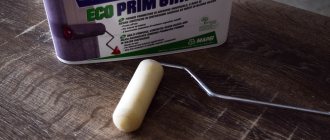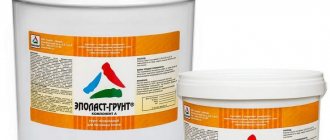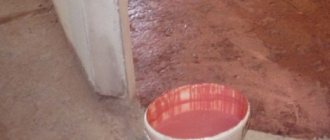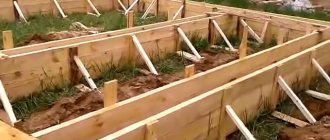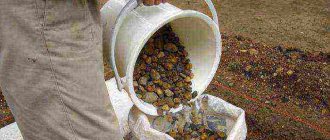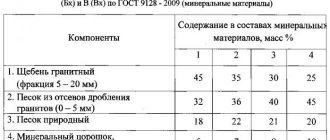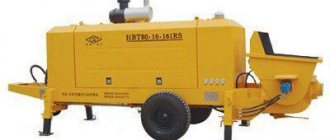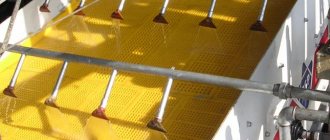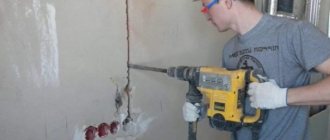"Birss ground-p"
"BIRSS Grunt-P"
Primer for porous substrates.
TU 2316-015-05668056-05 amended. No. 1,2 “Water-dispersion primers”
Certificate of Conformity No. ROSS RU.ХП22.Н00115
Sanitary and epidemiological conclusion No. 77.01.16.231.P.080859.09.08
DESCRIPTION:
A primer based on acrylic dispersion, due to its high penetrating ability, deeply impregnates the protected surface, strengthens it, regulates moisture absorption, and increases adhesion to the base. Forms a colorless film.
APPLICATION AREA:
"BIRSS Grunt-P" is intended for priming porous bases and floors. Prevents the penetration of water into the base and promotes the spreading of bulk compounds.
BASE REQUIREMENTS:
The surface to be treated must be hard, dry, free of substances that interfere with normal adhesion, such as dust, dirt, organic contaminants, and flaking elements.
MODE OF APPLICATION:
"BIRSS Grunt-P" is applied with a brush, roller or spray gun. On loose substrates with high absorption, the primer is applied in two layers. Drying time is at least 1 hour at a temperature of 20°C and a relative humidity of 60%. Use at a temperature not lower than +5°C.
MATERIAL CONSUMPTION:
Consumption 200 - 250 g per 1 m2 (depending on the porosity of the base).
PACKAGE:
Plastic containers of 10 kg, 50 kg.
The manufacturer guarantees that the product meets the technical specifications.
The manufacturer is not responsible for the incorrect use of the material, as well as for its use for purposes and conditions not provided for in these instructions.
Back to section
Primer concrete contact technical characteristics
During application of the primer, a rough surface is formed on the treated area, which provides better adhesion of the concrete to the materials for further finishing.
Concrete contact not only increases the degree of surface adhesion, but also eliminates microcracks, filling voids, thereby making the base stronger. The primer is designed for interior and facade work; it is applied to the cleaned surface of walls and ceilings of any concrete structures. Surface priming work is carried out before the start of facing work, such as plastering or leveling.
Primer Concrete Contact is a microporous primer with high adhesiveness, created for dense and smooth, poorly absorbed surfaces. This type of primer is especially suitable for concrete, but it is also easy to apply to substrates such as silicone, alkyd paint coatings, concrete mounting blocks, oil-based substrates and unglazed ceramic tiles. Soil Concrete Contact is capable of imparting roughness to any surface and providing reliable adhesion of the base itself to other finishing materials, for example, polymer and dry plasters and putties, tiles and wall coverings. In addition, Concrete Contact is a fairly durable material.
Primer is a mandatory element before coating cement-sand and cement-lime mortars for plastering.
If the concrete is not pre-treated with Betonokontakt, the plaster will crack and peel off. Concrete contact priming solution is used only for concrete structures; before applying it, the surface must be properly prepared: The base must be not only clean, but also dry.
It is known that gypsum plaster, putty and paint are applied only to the prepared surface, otherwise the materials will almost certainly crumble after drying and during further use. This universal product improves the adhesion of materials and strengthens the surface being treated, increasing its moisture resistance and resistance to any mechanical stress. Important information! Under no circumstances should it be used before plastering with cement mixtures.
Priming is not carried out in wet or icy areas. Standards for preparing the base before applying priming solutions are regulated by SNiP 3.
Contents 1 Properties and characteristics of concrete contact primer 1. The way out of this situation is concrete contact primer, the characteristics of which are several times greater than the properties of ordinary soils. Concrete contact is a styrene-acrylic dispersion consisting of water, technological additives, filler and pigment. Concrete contact primer becomes unique due to its special composition, the main role in which is played by fillers with a certain granulometry.
The primer is supplied completely ready for use; you just need to mix the solution. The primer is applied in a thin layer with a thickness of 1 mm to 1.5 mm, depending on the technology, the surface is processed once or twice. Before applying the second layer, you must wait at least three hours for the first layer to dry completely.
If the room humidity is high and the temperature is low, the primer will take longer to dry. It is forbidden to use the primer in winter, during fog, after rain and in windy weather. During work, it is necessary to protect the surface of the skin, eyes and nasal cavity from contact with the primer. For this purpose, rubber gloves, safety glasses and a respirator are used. What is concrete contact?
Before directly applying paints and varnishes or performing plastering work, preliminary surface preparation is required. Otherwise, this work will not last long and soon the surface will peel off and crumble. The properties of concrete contact consist not only of ideal adhesion of materials, but also of the treated surfaces it imparts resistance from external mechanical and chemical influences.
Site search
Where is primer used and where can it be used? Why do you need to apply an additional layer? What is a primer? The following will help answer all these questions:. The name concrete contact primer at first glance suggests that it can be used to process concrete, but this is a misconception. Concrete contact primers can be used to coat the following surfaces:.
Drying time also depends on the condition of the surface. When applying a concrete contact primer, including axton, to the surface, the following subtleties must be taken into account:. Cart of goods: 0. Home Price list Delivery Contacts. Decorazza decorative paints Decorazza textured coatings Venetian plaster Preparatory materials. Soil Concrete Contact.
Product code: 6 kg. Tex offers BC that reddens the surface so you can control the uniformity. Home-grown builders do not know that each primer has a limited area of application. If your brick is completely smooth, they may be right. Otherwise, look for another primer. Read the description on the package; this is often more useful than consulting with an ignorant person. The BC produced by the company Starateli will withstand the street environment.
It contains additives that increase moisture, frost resistance and antiseptic properties.
Specifications
If the amount of work is large, by choosing the appropriate composition, you will not only strengthen the base and extend the service life of the finish, but also save money. Large companies develop primers specifically for their materials. The companies Starateli and Knauf have lines of building materials.
Such products are tested together. Remove old coating if possible. It is convenient to clean plaster and putty with a wire brush; the whitewash must also be removed. Clean the base from excess grease with baking soda or detergent.
This way nothing will interfere with reliable contact between the primer and the base. In no case, this is a violation of operating technology. Before use, mix the primer thoroughly with a mixer so that there are no lumps in it.
The higher the moisture absorption of the material, the more primer you need to use. At what temperature is it used? It all depends on the manufacturer, the average drying time is 6 hours. Immediately rinse brushes and rollers with water.
Birss ground-ksh
Intended for external and internal work on concrete, plaster, putty, brickwork, etc. Forms a colorless film.
Technical characteristics of the BIRSS Grunt-KSh primer:
- Consumption 200-250 g/m²
- Drying time is at least an hour at a temperature of 20°C and a relative humidity of 60%.
- Use at temperatures not lower than +5°C
Requirements for the base of the BIRSS Grunt-KSh primer:
The surface to be treated must be dry, clean, free of separating layers and contaminants (dust, chalk, etc.)
Method of application of the BIRSS Grunt-KSh primer:
BIRSS Grunt-KSh is applied with a brush, roller or spray gun. On loose substrates with high absorption, the primer is applied in two layers. Drying time is at least 1 hour at a temperature of 200C and a relative humidity of 60%. Use at a temperature not lower than +50C.
Primer consumption BIRSS Grunt-KSh:
Consumption 200-250g per 1m2 (depending on the porosity of the base).
Package:
Plastic containers of 5 liters - price 375 rubles
Plastic containers of 10 l - price 1725 rubles
Birss primer
Birss primer is a professional material for preparing surfaces for decoration. Helps increase the adhesion of walls, floors, ceilings, furniture, reliability and durability of finishes, optimizes the consumption of final finishing products.
Available in several types, adapted for working with structures made of metal, concrete, wood and other materials.
The modifications “Concrete-Contact”, “Gidrofob”, “Soil ER-RV”, “Repair”, soils “ST-P”, “M”, “P”, “In-Harts”, “Leitlak”, are widely used. "Primer-Flex", "Tifen", "Hartz DPM".
Birss primers, depending on the formula, have additional useful properties: increased penetration depth (this parameter is useful when processing recently plastered surfaces), aseptic, anti-corrosion, strengthening characteristics, vapor permeability, strength, frost resistance, ease of use. When choosing and using compositions in accordance with operating conditions and the structure of the base, it is possible to obtain reliable and high-quality results without wasting extra time and money.
The advantages of Birss primer include its availability - the price of the product is significantly lower than the cost of imported analogues. At the same time, the manufacturer’s own unique developments ensure very high quality of each product and full compliance with standards and GOSTs.
Technology of use
Applying water-dispersion primers to surfaces is extremely simple. The technology of their use includes three main stages:
- surface preparation;
- preparing the primer itself;
- actual application.
Before priming, walls and ceilings are thoroughly cleaned of dirt, leveled and dried if necessary. The composition itself is shaken before application. If it is too viscous, add a little water to it. Apply the primer to the surface with a roller in a thin, even layer. Such products should be rubbed into the walls as thoroughly as possible.
This is exactly how surfaces are treated before painting, for example, using the Birss Concrete Contact water-dispersion primer, anti-corrosion compounds, deep penetration and any others.
Source
